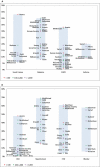Age, Multiple Chronic Conditions, and COVID-19: A Literature Review
- PMID: 33367606
- PMCID: PMC7799222
- DOI: 10.1093/gerona/glaa320
Age, Multiple Chronic Conditions, and COVID-19: A Literature Review
Abstract
Background: Various patient demographic and clinical characteristics have been associated with poor outcomes for individuals with coronavirus disease 2019 (COVID-19). To describe the importance of age and chronic conditions in predicting COVID-19-related outcomes.
Methods: Search strategies were conducted in PubMed/MEDLINE. Daily alerts were created.
Results: A total of 28 studies met our inclusion criteria. Studies varied broadly in sample size (n = 21 to more than 17,000,000). Participants' mean age ranged from 48 years to 80 years, and the proportion of male participants ranged from 44% to 82%. The most prevalent underlying conditions in patients with COVID-19 were hypertension (range: 15%-69%), diabetes (8%-40%), cardiovascular disease (CVD) (4%-61%), chronic pulmonary disease (1%-33%), and chronic kidney disease (range 1%-48%). These conditions were each associated with an increased in-hospital case fatality rate (CFR) ranging from 1% to 56%. Overall, older adults have a substantially higher case fatality rate (CFR) as compared to younger individuals affected by COVID-19 (42% for those <65 vs 65% > 65 years). Only one study examined the association of chronic conditions and the risk of dying across different age groups; their findings suggested similar trends of increased risk in those < 65 years and those > 65 years as compared to those without these conditions.
Conclusions: There has been a traditional, single-condition approach to consideration of how chronic conditions and advancing age relate to COVID-19 outcomes. A more complete picture of the impact of burden of multimorbidity and advancing patient age is needed.
Keywords: COVID-19; Epidemiology; Multimorbidity.
© The Author(s) 2020. Published by Oxford University Press on behalf of The Gerontological Society of America. All rights reserved. For permissions, please e-mail: journals.permissions@oup.com.
Figures
Similar articles
-
The association between patients' frailty status, multimorbidity, and demographic characteristics and changes in primary care for chronic conditions during the COVID-19 pandemic: a pre-post study.Fam Pract. 2023 Nov 23;40(4):523-530. doi: 10.1093/fampra/cmad089. Fam Pract. 2023. PMID: 37624946
-
The epidemiological burden and overall distribution of chronic comorbidities in coronavirus disease-2019 among 202,005 infected patients: evidence from a systematic review and meta-analysis.Infection. 2020 Dec;48(6):813-833. doi: 10.1007/s15010-020-01502-8. Epub 2020 Aug 19. Infection. 2020. PMID: 32813220 Free PMC article.
-
Older adults with non-communicable chronic conditions and their health care access amid COVID-19 pandemic in Bangladesh: Findings from a cross-sectional study.PLoS One. 2021 Jul 29;16(7):e0255534. doi: 10.1371/journal.pone.0255534. eCollection 2021. PLoS One. 2021. PMID: 34324556 Free PMC article.
-
Multimorbidity characteristics in older adults and their associated factors in complex networks: a cross-sectional study.Front Public Health. 2025 Feb 26;13:1473572. doi: 10.3389/fpubh.2025.1473572. eCollection 2025. Front Public Health. 2025. PMID: 40078767 Free PMC article.
-
Universal screening for SARS-CoV-2 infection: a rapid review.Cochrane Database Syst Rev. 2020 Sep 15;9(9):CD013718. doi: 10.1002/14651858.CD013718. Cochrane Database Syst Rev. 2020. PMID: 33502003 Free PMC article.
Cited by
-
Impact of medical-nursing combined policy pilot on hospitalization frequency of middle-aged and older patients with chronic diseases: a quasi-experimental study based on China Health and Retirement Longitudinal Study.Front Public Health. 2024 Oct 11;12:1450828. doi: 10.3389/fpubh.2024.1450828. eCollection 2024. Front Public Health. 2024. PMID: 39463894 Free PMC article.
-
Family Caregivers' Experiences and Changes in Caregiving Tasks During the COVID-19 Pandemic.Clin Nurs Res. 2021 Sep;30(7):1088-1097. doi: 10.1177/10547738211014211. Epub 2021 May 17. Clin Nurs Res. 2021. PMID: 33998836 Free PMC article.
-
Clinical outcomes of COVID-19 infection in patients with osteoporosis: a nationwide cohort study in Korea using the common data model.Sci Rep. 2024 Jul 31;14(1):17738. doi: 10.1038/s41598-024-68356-0. Sci Rep. 2024. PMID: 39085367 Free PMC article.
-
COVID or not COVID: attributing and reporting cause of death in a community cohort.Public Health. 2022 Apr;205:157-163. doi: 10.1016/j.puhe.2022.02.008. Epub 2022 Mar 11. Public Health. 2022. PMID: 35287022 Free PMC article.
-
The interplay of post-acute COVID-19 syndrome and aging: a biological, clinical and public health approach.Ageing Res Rev. 2022 Nov;81:101686. doi: 10.1016/j.arr.2022.101686. Epub 2022 Jul 9. Ageing Res Rev. 2022. PMID: 35820609 Free PMC article. Review.
References
-
- Coronaviridae Study Group of the International Committee on Taxonomy of V. The species severe acute respiratory syndrome-related coronavirus: classifying 2019-nCoV and naming it SARS-CoV-2. Nat Microbiol. 2020;5(4):536–544. doi:10.1038/s41564-020-0695-z - DOI - PMC - PubMed
-
- WHO. WHO Director-General’s Opening Remarks at the Media Briefing on COVID-19 - 11 March 2020. 2020. https://www.who.int/director-general/speeches/detail/who-director-genera.... Accessed April 23, 2020.
-
- WHO. Coronavirus Disease (COVID-19) Situation Report – 168 2020. https://www.who.int/emergencies/diseases/novel-coronavirus-2019/situatio...
-
- Centers for Disease Control and Prevention. Coronavirus Disease 2019 (COVID-19): Older Adults. https://www.cdc.gov/coronavirus/2019-ncov/community/retirement/checklist.... Accessed November 22, 2020.
-
- Arentz M, Yim E, Klaff L, et al. . Characteristics and outcomes of 21 critically ill patients with COVID-19 in Washington State. JAMA. 2020;323:1612–1614. doi:10.1001/jama.2020.4326 - DOI - PMC - PubMed
Publication types
MeSH terms
Grants and funding
LinkOut - more resources
Full Text Sources
Medical
Miscellaneous



